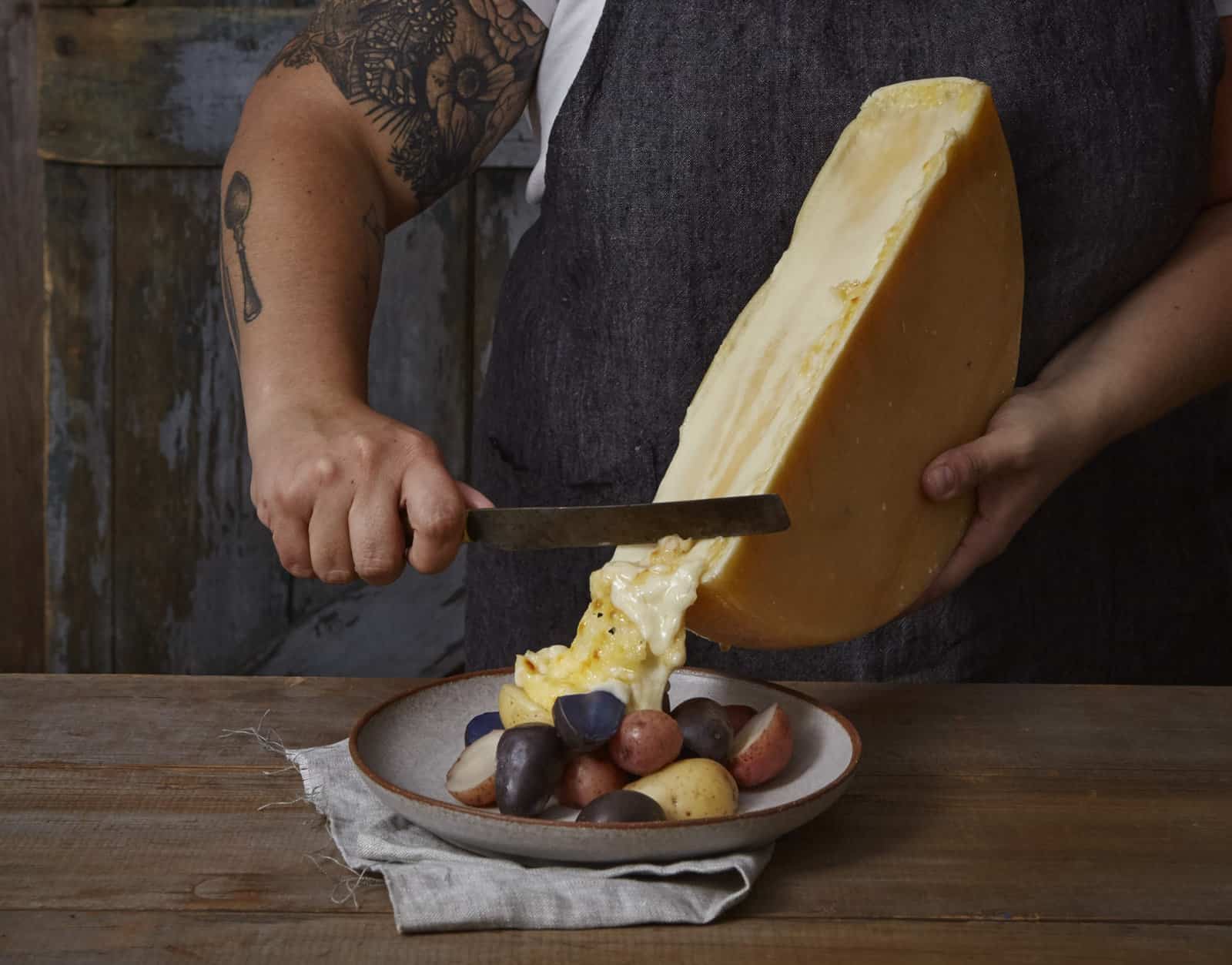
Watching raclette’s journey from wheel to the plate is a study in dramatic structure. First, the exposition: The characters and setting are established. I watch Eddy Baillifard, a master Swiss racleur, position a half-wheel of cheese beneath a smoldering toaster. Then, rising action: The exposed paste of the half-wheel begins to bubble. As it grows from a dispersed effervescence into popping vesicles, I begin to hear a sizzling.
“The song of the raclette,” Baillifard says. He points to the toasting surface. “When it starts to make those blisters, it starts to become caramelized—that’s how you know it’s ready.” The climax: He swings the half-wheel out from beneath the heat, takes it in one hand, and perches above a plate as the top starts to ooze. And then, falling action: With the swoop of a knife, he pushes the gooey surface downward, and a thick wave of melted cheese shrugs itself gracefully onto my plate. Catharsis: Potatoes, cornichons, a bit of pepper. I jumble it together; I eat.
HIGH ON RACLETTE
Baillifard lives and breathes melted cheese. When he’s not manning raclette grills at food festivals around the world, you’ll find him in his tiny Bruson, Switzerland–based restaurant, Raclett’House Chez Eddy, rocking a T-shirt that says Elevé au fromage de Bagnes—“raised on the cheese of the Bagnes.” Here in the high-altitude Bagnes Valley, everyone grows up eating the local fromage. It’s a semi-firm wheel, about a foot in diameter, aged two to three months. Made with raw, full-fat cow’s milk, it’s unctuous and creamy, with a golden-brown, slightly stinky rind. And it melts like a dream.
Nobody knows who threw the first raclette party, but some claim it happened in this valley. At least, “if you ask some older people, they might tell you that,” says Marc Dubosson, who makes fromage de Bagnes alongside his father, Roger, at the Laiterie de Verbier, a small dairy nearby. Dubosson recounts the local lore: “There’s a legend,” he says, of “a shepherd who left his cheese too close to a fire one night, and it melted.”
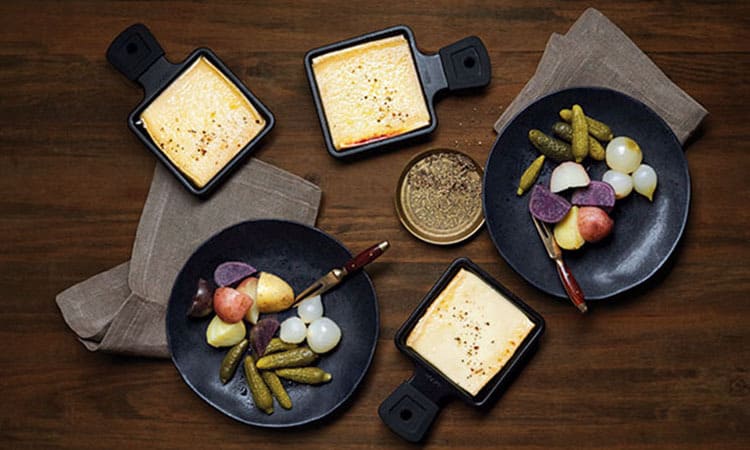 Fable or not, historic research points to the Valais—a Swiss state sprinkled with valleys like the Bagnes, each with similar cheeses and locals with a penchant for melting—as the tradition’s homeland. Here, the word raclette (based on the French racler, meaning “to scrape”) was first used to describe both a type of cheese and a dish. In an early account, a 16th-century pharmacist in the capital city of Sion detailed his idea of a good time: “We melt in front of the fire cheeses that are fatty, sweet, and tender,” he wrote. “And it is so good, that we cannot be satisfied.”
Fable or not, historic research points to the Valais—a Swiss state sprinkled with valleys like the Bagnes, each with similar cheeses and locals with a penchant for melting—as the tradition’s homeland. Here, the word raclette (based on the French racler, meaning “to scrape”) was first used to describe both a type of cheese and a dish. In an early account, a 16th-century pharmacist in the capital city of Sion detailed his idea of a good time: “We melt in front of the fire cheeses that are fatty, sweet, and tender,” he wrote. “And it is so good, that we cannot be satisfied.”
BEYOND THE MOUNTAINS
The melting tradition stayed hidden in these valleys until the 1960s when it started to catch on in nearby regions of France and Italy. Over the following decades, “raclette” cheeses popped up throughout Europe—but these were younger, ready-to-melt, pre-packaged wedges, bearing little resemblance to the Alpine wheels traditionally melted in the Valais. French native and Leelanau Cheese co-founder Anne Hoyt didn’t eat raclette growing up, but she remembers when versions of the cheese first hit French supermarket shelves in the 1980s. Today, the same styles are found across Europe. “They’re very soft,” she says. “You can’t slice them or cube them—they’re just made for melting.”
Tyler Hefferon, director of operations at Raclette restaurant in New York City, notes the same tendency among non-Swiss versions of the cheese. When melting wheels in the traditional way, those softer cheeses don’t lend themselves to scraping directly off the wheel, instead turning “into a liquid, kind of like a fondue,” he says. Cave-aged Alpine wheels from Switzerland are sturdier, with a rind that stands up to the heat. “You get those crispy, burnt edges,” he says.
Starting in the early 2000s, producers of Alpine wheels in the Valais, including makers of fromage de Bagnes, began working together to certify their cheeses with the Appellation d’Origine Protégée (AOP) label. It was finally entered into law in 2003, with the AOP grouping traditional cheeses used for raclette under a single name—Raclette du Valais in French, Walliser Raclette in the state’s German-speaking towns—to help differentiate wheels made in true local tradition.
Anne Hoyt first tasted the real thing while living in Switzerland, where she and her husband, Detroit native John Hoyt, worked making wheels of raclette on a high mountain pasture during summertime. Wanting to open their own dairy, the couple decided to return to the United States, where no artisan raclette—at least in traditional Swiss style—was being made. “It was something unique,” Anne remembers.
The duo founded Leelanau Cheese in Leelanau, Mich., in 1995 (the company has since moved to Suttons Bay).
At first, it took considerable effort to explain the tradition to Americans, but increased access to information and raclette-melting supplies has helped spread its popularity. All along the way, the Hoyts have remained as true to Swiss cheesemaking tradition as possible, evidenced by a legion of Swiss expats who have been loyal customers for decades. In 2016, the duo received a further confirmation of their success: a prestigious Super Gold medal at the World Cheese Awards.
GO WITH THE FLOW
The Hoyts’ win on the world stage is impressive because making a good raclette isn’t easy. First, it has to ooze elegantly. “Great raclette has this ability to melt at a really low temperature, and flow,” says Jeremy Stephenson of Vermont-based Spring Brook Farm. As cheese program director, he oversees the production of another award-winning raclette-style wheel called Reading. Creating meltable cheese is a challenge of balancing fat, protein, and moisture. When it gets hot enough, milkfat liquefies. That helps cheese soften—but as the protein strands forming its backbone start losing structure, the fat leaches out. To prevent that separation, the ratio of fat to protein needs to be just right.
A good raclette also needs a high enough level of moisture to melt; in drier cheeses, protein molecules are bonded together more closely. But if it’s too moist, it can’t be matured for several months—and the aging process is necessary for proper development of aroma, as enzymes break down the curd into flavorful fragments that increase in complexity over time.Stephenson argues that flavor complexity is what sets a truly good raclette apart. “It goes back to having high-quality milk,” he says. Marc Dubosson, maker at the dairy in Verbier, agrees. The most important part of the Raclette du Valais AOP, he says, is that it requires raw milk from cows grazing on grass or dry hay. As a result, wheels reflect mountain pasture and the seasons. “The best raclette is from the months of May, June, July,” he says, “when you have the best grass and the cows are outside.”
HOT MESS
A few years ago, Stephenson traveled to meet Dubosson at the Laiterie de Verbier and witness raclette-making firsthand. “People say you have to melt raclette, but that’s not really true,” the Vermonter says. “When I visited, I learned that they were making something quite versatile, so high-quality that it’s a beautiful table cheese.” Dining with the locals was an eye-opening experience in a region where cheese platters include diverse wedges of unmelted fromage de Bagnes: wheels from different high-altitude summer pastures, goat’s and sheep’s milk styles, and even a one-year-aged version known locally as fromage à rebibes.
Anne and John Hoyt also aim for versatility with their cheese, aging it at least three months, a bit longer than other versions on the US market. “Our raclette is a cheese you can have both ways,” she says. “You can eat it without melting it, at a picnic…people snack on it.” While quality raclettes are complex enough to hold their own on a cheese plate, there’s no denying that melting sparks a transformation. When subjected to heat, the volatile flavor compounds in cheese—the ones small and light enough to float in the air and eventually reach our noses—travel more easily. At the same time, a toaster’s smolder causes browning reactions between sugars and amino acids on the cheese’s surface, creating a range of other aromas.
“Melting,” Hoyt says, “is the beauty of it.” The result? An explosion of flavor: fruity and hoppy scents of green pasture, infinite layers of buttery, meaty aromas from diverse raw milk microflora, pungency of the rind, and the nutty, roasted notes of the singed surface. “It becomes a different cheese,” Stephenson says. “It’s over the top.” And a single melted morsel of it is never enough. But rest assured, meals of raclette are long and bountiful. At Baillifard’s restaurant, ordering it off the menu yields hot portions scraped off the wheel over and over again until you’re bursting at the seams—sequel after sequel to cheese’s most divine drama.
TASTING NOTES
FROMAGE DE BAGNES
Laiterie de Verbier
Verbier, Switzerland
Raw cow’s milk
This Raclette du Valais AOP was named best raclette at the Swiss Cheese Awards in 2014, and we understand why: It’s got a sweet, fruity complexity with notes of ham and béchamel. When heated, the pliable paste oozes like a dream.
VIEUX BAGNES
Laiterie de Verbier
Verbier, Switzerland
Raw cow’s milk
The flexible-yet-dense texture of aged raclette reminds us of chocolate; its flavor yields notes of ham, pine resin, and mole sauce.
RACLETTE DE CHÈVRE DE L’ENTREMONT
La Fromathèque
Martigny-Croix, Switzerland
Raw goat’s milk
Lighter in hue than its cow’s milk relatives, this caprine twist on traditional Valaisan cheese has a smooth paste that melts in the mouth.

RACLETTE DE BREBIS DE L’ENTREMONT
La Fromathèque
Martigny-Croix, Switzerland
Raw sheep’s milk
Thanks to a boost of fat, sheep’s milk raclette separates quickly on the grill—but we love the way heat draws out its flavors of barnyard, grass, fresh cream, and Brazil nuts.
FROMAGE À REBIBES
Alpage de Mille
Prarreyer, Switzerland
Raw cow’s milk
Made on the summer alpage, this one-year-aged raclette has a mottled natural rind and a firm, buttercup-yellow paste. Smelling of barn floor and hay, the cheese has a strong, piquant taste, with notes of yogurt and butter.
SNOWMASS
Haystack Mountain
Longmont, CO.
Pasteurized cow’s milk
This new domestic raclette smells savory—think onions cooked in beef fat—with a whiff of rye bread and that signature washed-rind tang. Flavor begins with a pickle-y tartness that relaxes into a buttery finish with a hint of caraway.
MILD RACLETTE
Leelanau Cheese
Suttons Bay, MI.
Pasteurized cow’s milk
Firm and supple, with a pale yellow rind, Michigan’s home-grown raclette has notes of grass and yogurt on the nose. Its low-key flavor builds slowly, starting with pure cream and evolving into waves of barnyard and roast pork.
EMMI RACLETTE
Emmi
Various, Switzerland
Pasteurized cow’s milk
With aromas of dark chocolate and prosciutto, this addictive Swiss-made wheel yields savory notes of ham-and-pea soup, peanuts, and pork belly.
READING
Spring Brook Farm
Reading, Vt.
Raw cow’s milk
Made at an award-winning Vermont creamery, nutty Reading has a light pink-orange rind, hints of flowers and grass, and a pleasing, long-lasting complexity.
Check out our top picks for raclette grills here, and master your melting method.


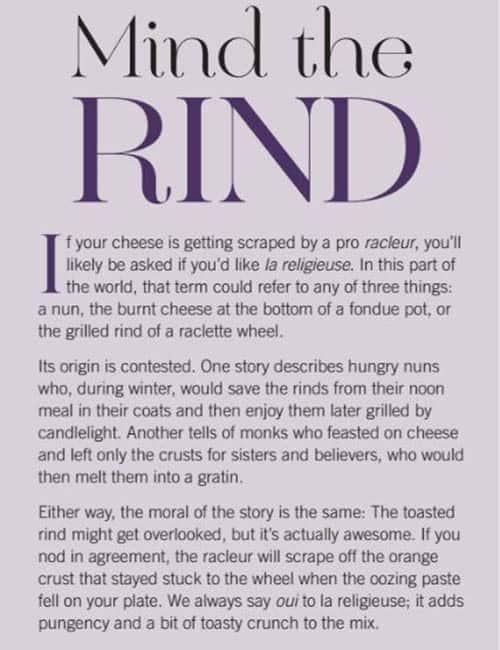
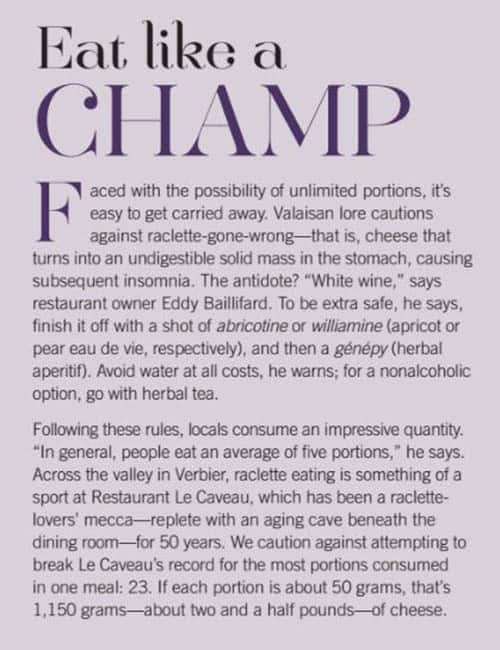
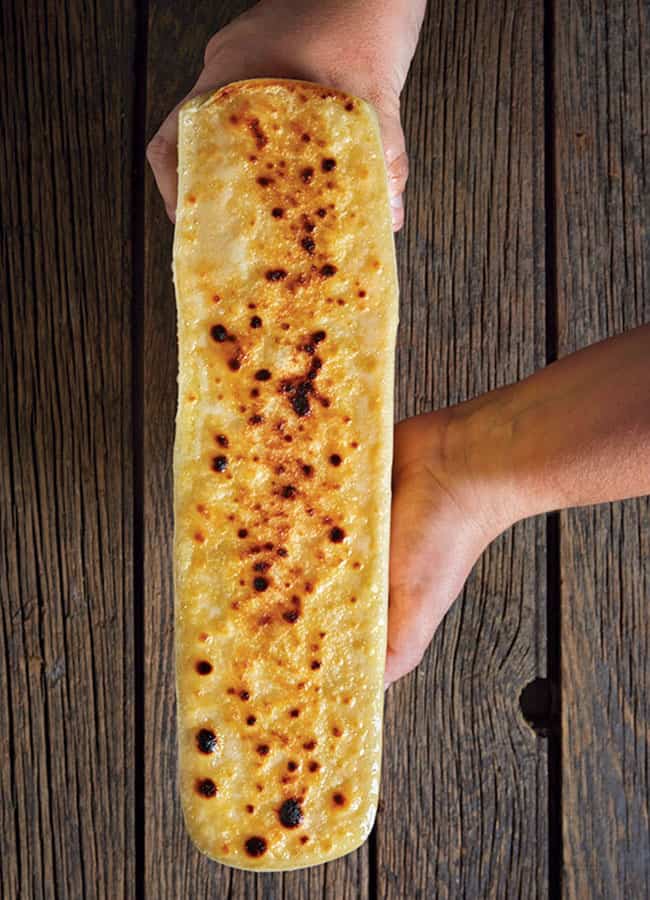


Great article. Very informative. Thank you.
What is the best restaurant in Zurich or Lucerne to experience a traditional raclette meal?
Thank you for that. At last a very well-informed article about our national dish. It’s absolutely right: “It goes back to having high-quality milk”. This is, of course, true for all varieties of cheese. “The best raclette is from the months of May, June, July,” he says, “when you have the best grass and the cows are outside.” Nowhere is the grass better than in the alps, at altitudes above 1000 m. And, there’s more to it than grass: of the up to 100 varieties of plants eaten by cows up there (compared to 3 to 6 in our industrialised, sanitized lowland agriculture), there are more varieties of herbs than grass, which make the milk even more special.
We are so glad you enjoyed this piece! Thanks for visiting!